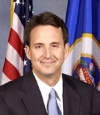Pawlenty on the Rebound? Governor’s Approval Rating Reaches Highest Mark in 2009
 Now more than two months removed from a brutal budget battle with the DFL, Minnesota Governor Tim Pawlenty has seen his approval numbers rise to its highest level this year, according to SurveyUSA’s latest ‘snapshot in time.’
Now more than two months removed from a brutal budget battle with the DFL, Minnesota Governor Tim Pawlenty has seen his approval numbers rise to its highest level this year, according to SurveyUSA’s latest ‘snapshot in time.’
Pawlenty’s approval rating for the month of July increased six points from June to 53 percent – tying January for his best mark of 2009. Forty-four percent of Minnesotans said they disapproved of Pawlenty’s job performance in a poll conducted of 600 adults from July 17-19.
Pawlenty’s return to moderately high approval numbers comes even as recent unemployment data continues to leave Minnesotans uncertain about the economic future of the state. June’s unemployment rate of 8.4 percent is the highest the Gopher State has endured in more than 25 years (April 1983).
While Pawlenty has not completely rebounded to his two-year approval rating high of 58 percent immediately after the 2008 election, this is the first statistically significant rise in job performance numbers for Pawlenty since the state’s jobless claims began to rise at a record pace last November.
Additionally, Governor Pawlenty has fared much better than many of his colleagues across the country. SurveyUSA tracks the approval ratings of approximately one-quarter of the nation’s governors, and Pawlenty’s 8.6 percent (5.0-point) drop in approval ratings from November 2008 to July 2009 is the third lowest in the 13-state sample. (Other states tracked are Alabama, California, Iowa, Kansas, Kentucky, Missouri, New Mexico, New York, Oregon, Virginia, Washington, and Wisconsin).
In fact, only Pawlenty, Democratic Governor Jay Nixon of Missouri, and Democratic Governor Steve Beshear of Kentucky have avoided job performance ratings drop by double digit percentages.
Neighboring Democratic Governor Jim Doyle of Wisconsin has seen his approval rating sliced by 27.3 percent (from 44 to 32 percent). Iowa’s Democratic Governor Chet Culver has endured a more modest, 13.7 percent drop, from 51 to 44 percent since November’s election.
And while Minnesota’s unemployment numbers are not as large as the country as a whole, several Governors who have suffered through a larger drop in approval ratings than Pawlenty currently serve in states with lower levels of unemployment (e.g. Tim Kaine of Virginia, David Paterson of New York, Chet Culver of Iowa, and Bill Richardson of New Mexico).
Change in Gubernatorial Approval Rating Since November 2008
|
State
|
Governor
|
Nov.
|
July
|
Diff.
|
% Diff.
|
% Unemploy.
|
|
KY
|
Beshear
|
47
|
48
|
+1
|
+2.1
|
10.9
|
|
MO
|
Nixon
|
63
|
60
|
-3
|
-4.8
|
9.3
|
|
MN
|
Pawlenty
|
58
|
53
|
-5
|
-8.6
|
8.4
|
|
VA
|
Kaine
|
54
|
47
|
-7
|
-13.0
|
7.2
|
|
IA
|
Culver
|
51
|
44
|
-7
|
-13.7
|
6.2
|
|
WA
|
Gregoire
|
42
|
35
|
-7
|
-16.7
|
9.3
|
|
AL
|
Riley
|
66
|
55
|
-11
|
-16.7
|
10.1
|
|
NM
|
Richardson
|
59
|
49
|
-10
|
-16.9
|
6.8
|
|
OR
|
Kulongoski
|
43
|
35
|
-8
|
-18.6
|
12.2
|
|
WI
|
Doyle
|
44
|
32
|
-12
|
-27.3
|
9.0
|
|
NY
|
Paterson
|
53
|
25
|
-28
|
-52.8
|
8.7
|
|
CA
|
Schwarzenegger
|
41
|
18
|
-23
|
-56.1
|
11.6
|
|
KS
|
Parkinson
|
N/A
|
41
|
N/A
|
N/A
|
7.0
|
|
|
Average
|
47.8
|
41.7
|
-9.2
|
-18.7
|
9.0
|
Note: SurveyUSA data compiled by Smart Politics. June 2009 unemployment data from the Bureau of Labor Statistics, U.S. Department of Labor.
Pawlenty and Nixon are also the only two governors in the SurveyUSA sample of states who currently have a higher job approval rating than the percentage of residents who last voted them into office.
Pawlenty’s +6 approval vis-à-vis vote mark rates the best, with Culver at -10 points and Doyle at -21 points below their 2006 vote percentages respectively.
Gubernatorial Vote vs. Approval Rating
|
State
|
Governor
|
Vote
|
Approval
|
Difference
|
|
MN
|
Pawlenty
|
47
|
53
|
+6
|
|
MO
|
Nixon
|
58
|
60
|
+2
|
|
AL
|
Riley
|
57
|
55
|
-2
|
|
VA
|
Kaine
|
52
|
47
|
-5
|
|
IA
|
Culver
|
54
|
44
|
-10
|
|
KY
|
Beshear
|
59
|
48
|
-11
|
|
OR
|
Kulongoski
|
51
|
35
|
-16
|
|
WA
|
Gregoire
|
53
|
35
|
-18
|
|
NM
|
Richardson
|
69
|
49
|
-20
|
|
WI
|
Doyle
|
53
|
32
|
-21
|
|
CA
|
Schwarzenegger
|
56
|
18
|
-38
|
Note: Parkinson (KS) and Paterson (NY) were not elected into office as Governor. Data compiled by Smart Politics.
Follow Smart Politics on Twitter.

Pawlenty is not getting the negative press that he had since the last measure of his popularity. Stands to reason he should be rising in the poll data.
The real impacts will be seen during the next biennium and the projected deficits that will accompany that budget. Ultimately the governors legacy and polling will be measured by the next budget and whether he was right not to raise taxes, or whether his gamble to benefit his political future will pay off for him and the state.